(全英)经典初中英语说课稿模板
- 格式:pdf
- 大小:52.61 KB
- 文档页数:5
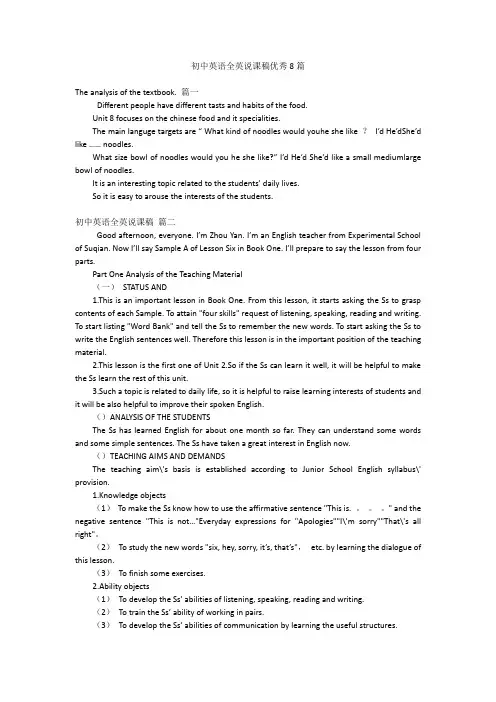
初中英语全英说课稿优秀8篇The analysis of the textbook. 篇一Different people have different tasts and habits of the food.Unit 8 focuses on the chinese food and it specialities.The main languge targets are “ What kind of noodles would youhe she like ?I’d He’dShe’d like …… noodles.What size bowl of noodles would you he she like?” I’d He’d She’d like a small mediumlarge bowl of noodles.It is an interesting topic related to the students’ daily lives.So it is easy to arouse the interests of the students.初中英语全英说课稿篇二Good afternoon, everyone. I’m Zhou Yan. I’m an English teacher from Experimental School of Suqian. Now I’ll say Sample A of Lesson Six in Book One. I’ll prepare to say the lesson from four parts.Part One Analysis of the Teaching Material(一)STATUS AND1.This is an important lesson in Book One. From this lesson, it starts asking the Ss to grasp contents of each Sample. To attain "four skills" request of listening, speaking, reading and writing. To start listing "Word Bank" and tell the Ss to remember the new words. To start asking the Ss to write the English sentences well. Therefore this lesson is in the important position of the teaching material.2.This lesson is the first one of Unit 2.So if the Ss can learn it well, it will be helpful to make the Ss learn the rest of this unit.3.Such a topic is related to daily life, so it is helpful to raise learning interests of students and it will be also helpful to improve their spoken English.()ANALYSIS OF THE STUDENTSThe Ss has learned English for about one month so far. They can understand some words and some simple sentences. The Ss have taken a great interest in English now.()TEACHING AIMS AND DEMANDSThe teaching aim\'s basis is established according to Junior School English syllabus\' provision.1.Knowledge objects(1)To make the Ss know how to use the affirmative sentence "This is. 。
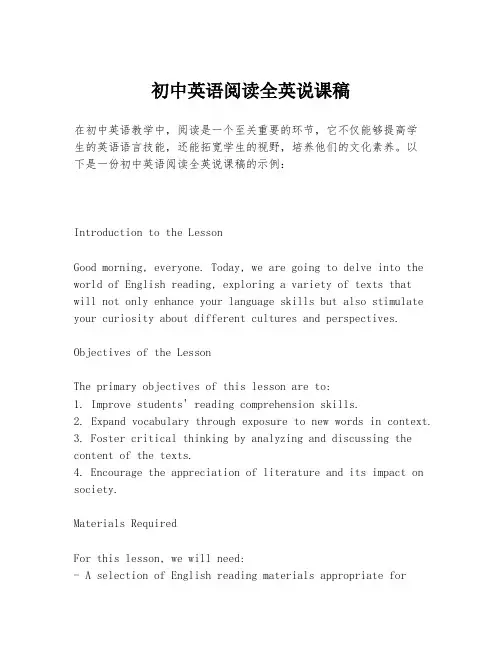
初中英语阅读全英说课稿在初中英语教学中,阅读是一个至关重要的环节,它不仅能够提高学生的英语语言技能,还能拓宽学生的视野,培养他们的文化素养。
以下是一份初中英语阅读全英说课稿的示例:Introduction to the LessonGood morning, everyone. Today, we are going to delve into the world of English reading, exploring a variety of texts thatwill not only enhance your language skills but also stimulate your curiosity about different cultures and perspectives.Objectives of the LessonThe primary objectives of this lesson are to:1. Improve students' reading comprehension skills.2. Expand vocabulary through exposure to new words in context.3. Foster critical thinking by analyzing and discussing the content of the texts.4. Encourage the appreciation of literature and its impact on society.Materials RequiredFor this lesson, we will need:- A selection of English reading materials appropriate forthe level of the students, which may include short stories, articles, and poems.- Handouts with comprehension questions and vocabulary exercises.- A whiteboard and markers for note-taking and discussion.Teaching Procedures1. Warm-up Activity (5 minutes)Begin the class with a quick vocabulary review game. Students will match new words to their definitions, setting the stage for the new vocabulary they will encounter in the reading.2. Introduction to the Text (10 minutes)Briefly introduce the text to be read, providing background information about the author and the context in which the text was written.3. Guided Reading (20 minutes)Students will read the text silently, following along with the teacher who will guide them through the reading, highlighting key vocabulary and phrases.4. Comprehension Check (15 minutes)After reading, conduct a comprehension check using the handouts provided. This will help assess students' understanding of the main ideas and details of the text.5. Vocabulary Expansion (10 minutes)Discuss new vocabulary words in the context of the text.Encourage students to use these words in sentences to reinforce their understanding.6. Group Discussion (15 minutes)Form small groups and have students discuss the themes, characters, and plot of the text. This will promote critical thinking and the ability to express opinions in English.7. Reflection and Feedback (5 minutes)Conclude the lesson by having students reflect on what they have learned and provide feedback on the reading experience.AssessmentStudents will be assessed based on their participation in discussions, the accuracy of their comprehension answers, and their ability to use new vocabulary in context.ConclusionReading in English is a journey of exploration and discovery. By engaging with diverse texts, we not only improve our language proficiency but also enrich our understanding of the world around us. I look forward to our shared journey through the pages of these fascinating texts.This lesson plan is designed to be interactive and student-centered, with a focus on developing both language skills and a deeper appreciation for the art of reading.。
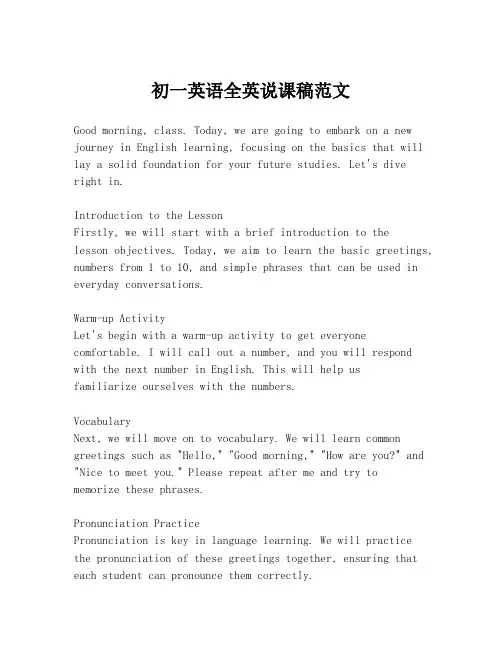
初一英语全英说课稿范文Good morning, class. Today, we are going to embark on a new journey in English learning, focusing on the basics that will lay a solid foundation for your future studies. Let's diveright in.Introduction to the LessonFirstly, we will start with a brief introduction to thelesson objectives. Today, we aim to learn the basic greetings, numbers from 1 to 10, and simple phrases that can be used in everyday conversations.Warm-up ActivityLet's begin with a warm-up activity to get everyone comfortable. I will call out a number, and you will respond with the next number in English. This will help usfamiliarize ourselves with the numbers.VocabularyNext, we will move on to vocabulary. We will learn common greetings such as "Hello," "Good morning," "How are you?" and "Nice to meet you." Please repeat after me and try to memorize these phrases.Pronunciation PracticePronunciation is key in language learning. We will practicethe pronunciation of these greetings together, ensuring that each student can pronounce them correctly.Dialogue PracticeNow, let's put our vocabulary into practice. We will role-play a few simple dialogues. For example:- A: Hello, what's your name?- B: My name is [Your Name]. Nice to meet you.Switch roles with your partner and practice this dialogue afew times.Grammar FocusToday's grammar focus will be on the simple present tense. We will learn how to use it in greetings and basic conversation.Reading ComprehensionWe will read a short passage together and discuss the content. This will help improve your reading skills and comprehension.Listening ExerciseWe will listen to a dialogue between two people and answer some questions about it. This will test your listening skills and understanding of the conversation.Writing TaskFinally, for our writing task, you will write a short paragraph about your day, using the vocabulary and grammar structures we have learned today.ConclusionAt the end of the lesson, we will review what we have learnedand address any questions you may have. Remember, practice makes perfect. Keep practicing the phrases and numbers we have learned today.HomeworkYour homework is to write a short dialogue between two friends meeting for the first time, using the greetings and phrases we have practiced today.I hope this lesson has been informative and enjoyable. Let's continue to explore the world of English together. Thank you for your attention, and I look forward to our next class.。
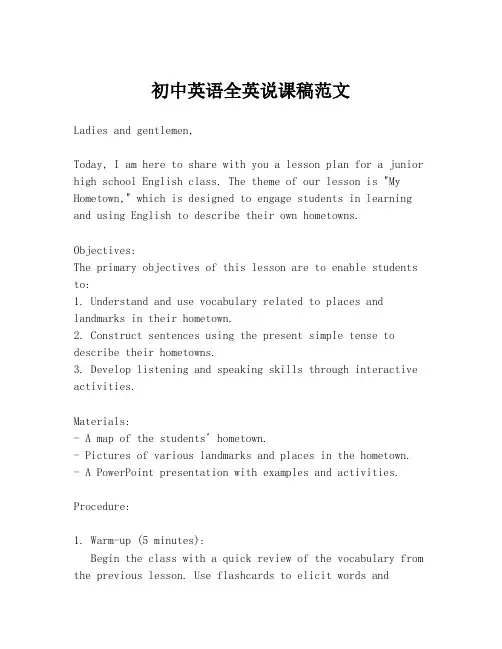
初中英语全英说课稿范文Ladies and gentlemen,Today, I am here to share with you a lesson plan for a junior high school English class. The theme of our lesson is "My Hometown," which is designed to engage students in learning and using English to describe their own hometowns.Objectives:The primary objectives of this lesson are to enable students to:1. Understand and use vocabulary related to places and landmarks in their hometown.2. Construct sentences using the present simple tense to describe their hometowns.3. Develop listening and speaking skills through interactive activities.Materials:- A map of the students' hometown.- Pictures of various landmarks and places in the hometown. - A PowerPoint presentation with examples and activities.Procedure:1. Warm-up (5 minutes):Begin the class with a quick review of the vocabulary from the previous lesson. Use flashcards to elicit words andphrases related to places and landmarks.2. Introduction (10 minutes):Show the students a map of their hometown and ask them to identify different places. Introduce new vocabulary such as "river," "park," "museum," and "historical site."3. Presentation (15 minutes):Use the PowerPoint to present sentences describing various places in a typical hometown. For example, "There is a beautiful park in the center of the city," or "The museum is located near the river."4. Practice (20 minutes):In pairs, students will take turns describing their hometown using the vocabulary and sentence structures introduced. Encourage them to use the present simple tense and to be creative with their descriptions.5. Listening Activity (10 minutes):Play a short audio clip describing a fictional hometown. After listening, students will answer comprehension questions in pairs.6. Group Work (15 minutes):Divide the class into small groups. Each group will create a poster of their hometown, including pictures and descriptions. They will then present their hometown to the class.7. Feedback and Correction (5 minutes):As the groups present, provide feedback on their use of language and encourage the class to correct any mistakes they notice.8. Wrap-up (5 minutes):Conclude the lesson by summarizing the key points and encouraging students to continue practicing their English by describing their hometowns to family and friends.Assessment:Students will be assessed on their participation in class activities, their ability to use the target language accurately, and their contributions to the group project.Differentiation:For advanced students, provide more complex sentences to construct and encourage them to use more sophisticated vocabulary. For struggling students, offer additional support and simpler sentence structures.Reflection:After the lesson, reflect on the effectiveness of the activities and consider any adjustments needed for future lessons to better meet the needs of all students.This concludes the lesson plan for "My Hometown." Thank you for your attention.。
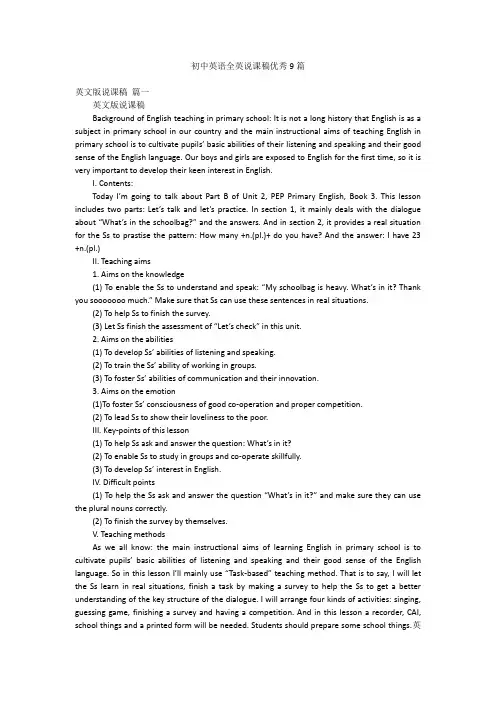
初中英语全英说课稿优秀9篇英文版说课稿篇一英文版说课稿Background of English teaching in primary school: It is not a long history that English is as a subject in primary school in our country and the main instructional aims of teaching English in primary school is to cultivate pupils’ basic abilities of their listening and speaking and their good sense of the English language. Our boys and girls are exposed to English for the first time, so it is very important to develop their keen interest in English.I. Contents:Today I’m going to talk about Part B of Unit 2, PEP Primary English, Book 3. This lesson includes two parts: Let’s talk and let’s practice. In section 1, it mainly deals with the dialogue about “What’s in the schoolbag?” and the answers. And in section 2, it provides a real situation for the Ss to prastise the pattern: How many +n.(pl.)+ do you have? And the answer: I have 23 +n.(pl.)II. Teaching aims1. Aims on the knowledge(1) To enable the Ss to understand and speak: “My schoolbag is heavy. What’s in it? Thank you sooooooo much.” Make sure that Ss can use these sentences in real situations.(2) To help Ss to finish the survey.(3) Let Ss finish the assessment of “Let’s check” in this unit.2. Aims on the abilities(1) To develop Ss’ abilities of listening and speaking.(2) To train the Ss’ ability of working in groups.(3) To foster Ss’ abilities of communication and their innovation.3. Aims on the emotion(1)To foster Ss’ consciousness of good co-operation and proper competition.(2) To lead Ss to show their loveliness to the poor.III. Key-points of this lesson(1) To help Ss ask and answer the question: What’s in it?(2) To enable Ss to study in groups and co-operate skillfully.(3) To develop Ss’ interest in English.IV. Difficult points(1) To help the Ss ask and answer the question “What’s in it?” and make sure they can use the plural nouns correctly.(2) To finish the survey by themselves.V. Teaching methodsAs we all know: the main instructional aims of learning English in primary school is to cultivate pupils’ basic abilities of listening and speaking and their good sense of the English language. So in this lesson I’ll mainly use “Task-based” teaching method. That is to say, I will let the Ss learn in real situations, finish a task by making a survey to help the Ss to get a better understanding of the key structure of the dialogue. I will arrange four kinds of activities: singing, guessing game, finishing a survey and having a competition. And in this lesson a recorder, CAI, school things and a printed form will be needed. Students should prepare some school things.英文版英语说课稿VI. Teaching procedures and purposes of my designing.I’ll finish this lesson in five steps.Step 1. Warm-up and preview1. Free talk between T and Ss about things in the classroom.2. Sing the song together: Books and pencils.3. Do some TPR, for example: Show me your English book. Show me your crayon.4. Review the numbers by asking: “How many crayons do you have?”Purpose: It is important to form a better English learning surrounding for the Ss by singing and doing some total physical response and at the same time it provides situations to review learned knowledge for the next step.Step 2. PresentationNow I’ll mainly talk about this step.1. Present the pattern: “My schoolbag is heavy.” “What’s in it?.”(1) Show a bag and say: “Look! I have a bag.” Carry it and say: “Oh, it is heavy. My schoolbag is heavy.” Help the Ss understand the meaning with the help of my body language. Then lead the Ss to read the sentence. Make sure they can say it correctly.(2) T: My schoolbag is heavy.Open the bag and say: “What’s in it? What’s in my schoolbag?”Take out a Chinese book. Then do the action again. Let the Ss read the sentence.2. Play a guessing game. Divide the whole class into four groups to have a competition.Let them guess: What’s in the bag? How many? Purpose: To present the key structures one by one is much easier for the Ss to learn and grasp the meanings. Proper competition can arouse the Ss’ interest in English learning.3. With the help of the CAI to present the dialogue. Set a situation to help Ss understand: Two Ss are coming. One girl is carrying a heavy bag on her back. They are talking.Girl: My schoolbag is heavy.Boy: What’s in it?Girl: 20 story-books, 32 pencil, 9 rulers, 12 crayons and 30 picture-books. Etc.Boy: What will you do?Girl: They are for the poor.Boy: Great! I’ll bring some school things too.The boy comes back home and puts a lot of things into the bag. Then he goes to school again and gives them to a teacher. While he is taking them out, he is counting the numbers of all things. The teacher says: Thank you soooooooo much.4. Mention that we should take care of the poor.5. Play the cassette. Let the Ss listen and imitate the dialogue.Pay attention to their pronunciation and intonation. Purpose: CAI can provide a real situation for the Ss to understand the dialogue and the relationships between people better. Tell the Ss we should show our loveliness to the Ss.Step 3. PracticeDivide Ss into groups of six children. Each one would finish the printed form by asking and answering: How many storybooks do you have? Find out which group finishes faster. Story books picture-books sharpeners crayons pencils erasers pencil-cases rulers Chen Jie 8 24 3 32 26 4 1 3Purpose: Task-based teaching method is used here to develop Ss’ ability of communication and also their ability of co-operation will be well trained.Step 4. AssessmentHelp Ss finish “Let’s check” of this unit and workbook.Purpose: To check the knowledge Ss have learned in this period.Step 5. Add-activity1. Let Ss tell each other how many school things they have after class. Tell their parents how many school things they have at home.2. Take care of everything they have.Purpose: Revision is so important that Ss should speak English as much as they as in class or after class. It is necessary for the Ss to do some extensive exercises after class to consolidate the knowledge they learned.英文版英语说课稿初中英语说课稿篇二今天我的说课内容是新目标英语八年级上册第四单元第一课时。
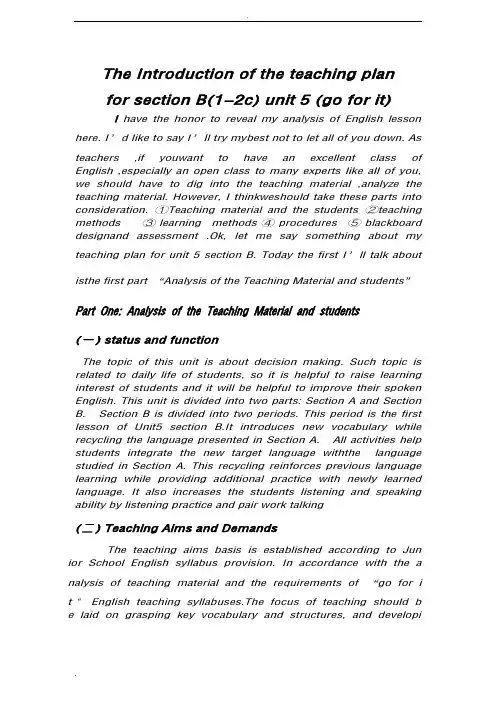
The Introduction of the teaching planfor section B(1-2c) unit 5 (go for it)I have the honor to reveal my analysis of English lessonhere. I’d like to say I’ll try mybest not to let all of you down. Asteachers ,if youwant to have an excellent class of English ,especially an open class to many experts like all of you, we should have to dig into the teaching material ,analyze the teaching material. However, I thinkweshould take these parts into consideration. ①Teaching material and the students ②teaching methods ③learning methods④procedures ⑤blackboard designand assessment .Ok, let me say something about myteaching plan for unit 5 section B. Today the first I’ll talk about isthe first part “Analysis of the Teaching Material and students”Part One: Analysis of the Teaching Material and students(一) status and functionThe topic of this unit is about decision making. Such topic is related to daily life of students, so it is helpful to raise learning interest of students and it will be helpful to improve their spoken English. This unit is divided into two parts: Section A and Section B. Section B is divided into two periods. This period is the first lesson of Unit5 section B.It introduces new vocabulary while recycling the language presented in Section A. All activities help students integrate the new target language withthe language studied in Section A. This recycling reinforces previous language learning while providing additional practice with newly learned language. It also increases the students listening and speaking ability by listening practice and pair work talking(二) Teaching Aims and DemandsThe teaching aims basis is established according to Jun ior School English syllabus provision. In accordance with the a nalysis of teaching material and the requirements of “go for i t"English teaching syllabuses.The focus of teaching should b e laid on grasping key vocabulary and structures, and developing the students’ability of munication. So I’vedesigned the f ollowing aims and demands1. Knowledge objectsKey vocabulary:agent; make money;travel around the world; get an education Target language:I think you should go to collegeBut if I go to college, I’ll never bee a great soc cer player.2. Ability objects:To train students’ability of listening and speakingTo train students’ability of munication3. Moral objects:Money isn’t everything.To be interested in taking part in activities in English class(三)Teaching key points and difficult points1. Key points:key phrases:travel around the world; make money; get an education key structures:I think you should …。
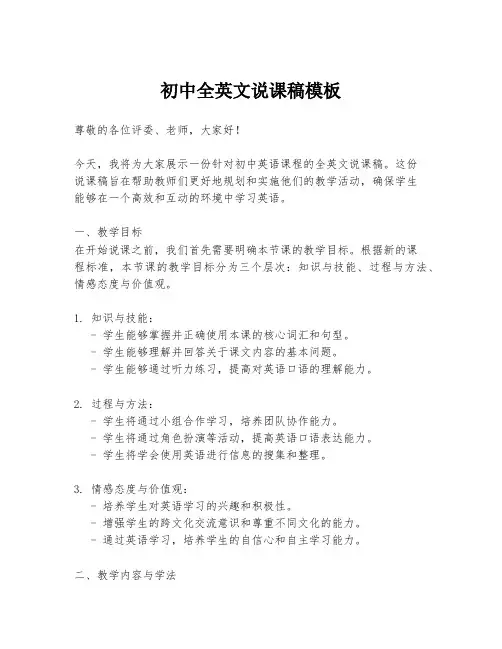
初中全英文说课稿模板尊敬的各位评委、老师,大家好!今天,我将为大家展示一份针对初中英语课程的全英文说课稿。
这份说课稿旨在帮助教师们更好地规划和实施他们的教学活动,确保学生能够在一个高效和互动的环境中学习英语。
一、教学目标在开始说课之前,我们首先需要明确本节课的教学目标。
根据新的课程标准,本节课的教学目标分为三个层次:知识与技能、过程与方法、情感态度与价值观。
1. 知识与技能:- 学生能够掌握并正确使用本课的核心词汇和句型。
- 学生能够理解并回答关于课文内容的基本问题。
- 学生能够通过听力练习,提高对英语口语的理解能力。
2. 过程与方法:- 学生将通过小组合作学习,培养团队协作能力。
- 学生将通过角色扮演等活动,提高英语口语表达能力。
- 学生将学会使用英语进行信息的搜集和整理。
3. 情感态度与价值观:- 培养学生对英语学习的兴趣和积极性。
- 增强学生的跨文化交流意识和尊重不同文化的能力。
- 通过英语学习,培养学生的自信心和自主学习能力。
二、教学内容与学法接下来,我将介绍本节课的教学内容和学法。
1. 教学内容:- 课文主题:介绍一种学生感兴趣的文化现象或社会问题。
- 核心词汇:列出与课文主题相关的5-10个新词汇。
- 重点句型:介绍2-3个与课文内容相关的实用句型。
2. 学法指导:- 通过图片、视频等多媒体材料,激发学生的学习兴趣。
- 利用思维导图等工具,帮助学生整理和记忆新词汇。
- 通过情景模拟和角色扮演,让学生在实践中学习和使用英语。
三、教学过程本节课的教学过程分为以下几个阶段:1. 导入新课- 通过一个与课文主题相关的小故事或问题,吸引学生的注意力,并引入新课内容。
2. 呈现新知- 教师清晰地呈现新词汇和句型,并提供例句。
- 学生跟读并模仿教师的发音,确保语音语调的准确性。
3. 练习与应用- 学生通过填空、连线等练习,巩固新词汇和句型。
- 小组合作,进行角色扮演或情景对话,将所学知识应用于实际交流中。
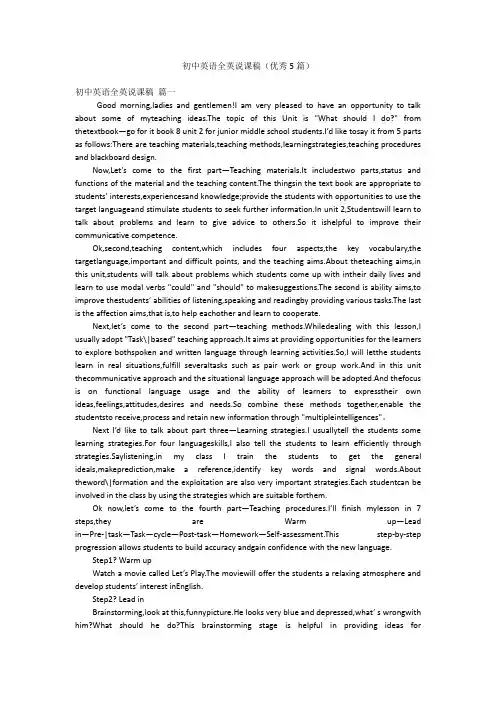
初中英语全英说课稿(优秀5篇)初中英语全英说课稿篇一Good morning,ladies and gentlemen!I am very pleased to have an opportunity to talk about some of myteaching ideas.The topic of this Unit is "What should I do?" from thetextbook—go for it book 8 unit 2 for junior middle school students.I’d like tosay it from 5 parts as follows:There are teaching materials,teaching methods,learningstrategies,teaching procedures and blackboard design.Now,Let’s come to the first part—Teaching materials.It includestwo parts,status and functions of the material and the teaching content.The thingsin the text book are appropriate to students’ interests,experiencesand knowledge;provide the students with opportunities to use the target languageand stimulate students to seek further information.In unit 2,Studentswill learn to talk about problems and learn to give advice to others.So it ishelpful to improve their communicative competence.Ok,second,teaching content,which includes four aspects,the key vocabulary,the targetlanguage,important and difficult points, and the teaching aims.About theteaching aims,in this unit,students will talk about problems which students come up with intheir daily lives and learn to use modal verbs "could" and "should" to makesuggestions.The second is ability aims,to improve thestudents’ abilities of listening,speaking and readingby providing various tasks.The last is the affection aims,that is,to help eachother and learn to cooperate.Next,let’s come to the second part—teaching methods.Whiledealing with this lesson,I usually adopt "Task\|based" teaching approach.It aims at providing opportunities for the learners to explore bothspoken and written language through learning activities.So,I will letthe students learn in real situations,fulfill severaltasks such as pair work or group work.And in this unit thecommunicative approach and the situational language approach will be adopted.And thefocus is on functional language usage and the ability of learners to expresstheir own ideas,feelings,attitudes,desires and needs.So combine these methods together,enable the studentsto receive,process and retain new information through "multipleintelligences"。
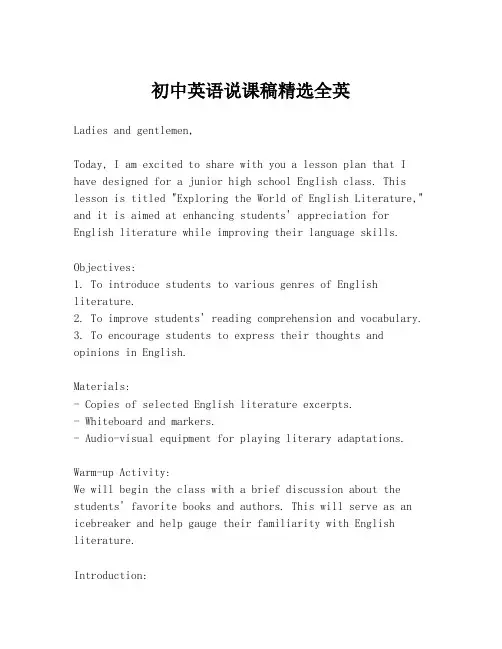
初中英语说课稿精选全英Ladies and gentlemen,Today, I am excited to share with you a lesson plan that I have designed for a junior high school English class. This lesson is titled "Exploring the World of English Literature," and it is aimed at enhancing students' appreciation for English literature while improving their language skills.Objectives:1. To introduce students to various genres of English literature.2. To improve students' reading comprehension and vocabulary.3. To encourage students to express their thoughts and opinions in English.Materials:- Copies of selected English literature excerpts.- Whiteboard and markers.- Audio-visual equipment for playing literary adaptations.Warm-up Activity:We will begin the class with a brief discussion about the students' favorite books and authors. This will serve as an icebreaker and help gauge their familiarity with English literature.Introduction:I will introduce the concept of literature and its importance in our lives. We will discuss the different genres, such as poetry, prose, and drama, and their unique characteristics.Reading Comprehension:Students will be divided into small groups and given excerpts from various English literary works. They will read the excerpts silently, followed by a group discussion to answer comprehension questions and share their interpretations.Vocabulary Enhancement:We will identify and discuss new vocabulary words from the excerpts. Students will be encouraged to use these words in sentences to reinforce their understanding.Literary Analysis:Next, we will delve into the analysis of the selected literature. Students will learn about literary devices such as metaphor, simile, and personification, and how they are used in the texts.Creative Writing:To apply their learning, students will be asked to write a short paragraph inspired by one of the literary works they have read. This will help them practice using new vocabulary and literary techniques.Conclusion:We will conclude the lesson by sharing the creative writing pieces with the class. This will provide an opportunity for peer feedback and further discussion.Homework:For homework, students will be asked to choose a piece of English literature that interests them and write a brief summary and analysis, focusing on the use of language and literary devices.Assessment:The lesson will be assessed through group participation, the quality of the creative writing, and the homework assignment.I believe this lesson plan will not only improve students' English language skills but also ignite a passion for English literature. Thank you for your attention, and I look forward to implementing this lesson in the classroom.。
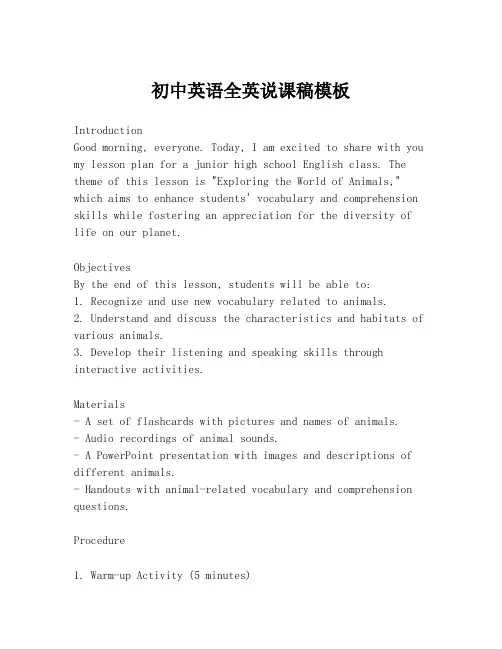
初中英语全英说课稿模板IntroductionGood morning, everyone. Today, I am excited to share with you my lesson plan for a junior high school English class. The theme of this lesson is "Exploring the World of Animals," which aims to enhance students' vocabulary and comprehension skills while fostering an appreciation for the diversity of life on our planet.ObjectivesBy the end of this lesson, students will be able to:1. Recognize and use new vocabulary related to animals.2. Understand and discuss the characteristics and habitats of various animals.3. Develop their listening and speaking skills through interactive activities.Materials- A set of flashcards with pictures and names of animals.- Audio recordings of animal sounds.- A PowerPoint presentation with images and descriptions of different animals.- Handouts with animal-related vocabulary and comprehension questions.Procedure1. Warm-up Activity (5 minutes)- Begin with a quick game where students mimic the soundsof various animals. This will not only engage the studentsbut also introduce the topic in a fun and interactive way.2. Vocabulary Introduction (10 minutes)- Introduce new vocabulary using flashcards. Encourage students to repeat the words after you and to use them in simple sentences.3. Listening Comprehension (15 minutes)- Play audio recordings of animal sounds and have students guess which animal is making the sound. This activity willtest their listening skills and reinforce the vocabulary they have just learned.4. Reading Comprehension (20 minutes)- Distribute handouts with a short passage about aspecific animal, its habitat, and its characteristics. Students will read the passage silently and then answer comprehension questions in pairs.5. Group Discussion (15 minutes)- Divide the class into small groups and have them discuss the animals they have learned about. Encourage them to usethe new vocabulary and to share their thoughts on the importance of conservation.6. Presentation (15 minutes)- Each group will choose an animal to present to the class. They will use the PowerPoint slides and their notes todescribe the animal, its habitat, and why it is important.7. Wrap-up (5 minutes)- Conclude the lesson by summarizing the key points and highlighting the importance of learning about the natural world. Encourage students to continue exploring the world of animals outside of the classroom.Assessment- Participation in group discussions and presentations.- Completion of the reading comprehension questions.- Use of new vocabulary in speaking and writing activities.Differentiation- Provide additional support for students who struggle with vocabulary by offering simpler descriptions or more examples. - Challenge advanced students with more complex vocabulary or by asking them to research and present on a less common animal.Reflection- After the lesson, reflect on the effectiveness of the activities and consider how they can be adapted for future lessons.This template provides a comprehensive structure for delivering an engaging and educational English lesson to junior high school students. Adjustments can be made based on the specific needs and interests of the students.。
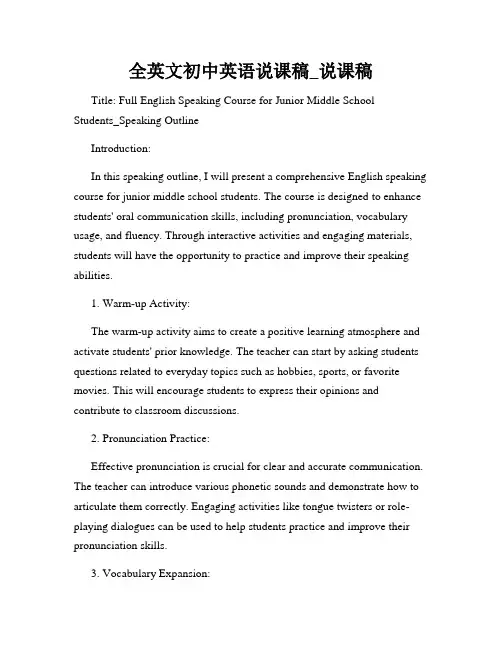
全英文初中英语说课稿_说课稿Title: Full English Speaking Course for Junior Middle School Students_Speaking OutlineIntroduction:In this speaking outline, I will present a comprehensive English speaking course for junior middle school students. The course is designed to enhance students' oral communication skills, including pronunciation, vocabulary usage, and fluency. Through interactive activities and engaging materials, students will have the opportunity to practice and improve their speaking abilities.1. Warm-up Activity:The warm-up activity aims to create a positive learning atmosphere and activate students' prior knowledge. The teacher can start by asking students questions related to everyday topics such as hobbies, sports, or favorite movies. This will encourage students to express their opinions and contribute to classroom discussions.2. Pronunciation Practice:Effective pronunciation is crucial for clear and accurate communication. The teacher can introduce various phonetic sounds and demonstrate how to articulate them correctly. Engaging activities like tongue twisters or role-playing dialogues can be used to help students practice and improve their pronunciation skills.3. Vocabulary Expansion:Enriching students' vocabulary is essential for effective communication. The teacher can introduce new words and phrases using real-life situations and vivid examples. Interactive games, vocabulary quizzes, or multimedia resources can be utilized to make the learning process more enjoyable and memorable.4. Speaking Activities:To develop students' speaking abilities, it is vital to provide ample opportunities for them to practice in class. The teacher can design speaking activities such as pair work, group discussions, or debates on topics of interest to the students. By encouraging students to express their thoughts and opinions, their confidence in speaking English will gradually improve.5. Role-Play:Role-play activities not only enhance students' speaking skills but also promote critical thinking and problem-solving abilities. The teacher can assign different roles to students and present various scenarios or simulations, such as ordering food in a restaurant or conducting a job interview. This will encourage students to use English in realistic contexts and develop their communication skills.6. Multimedia Resources:Utilizing multimedia resources like videos, podcasts, or online platforms can make the English speaking course more interactive and engaging. The teacher can incorporate these resources into lessons to provide authentic and diverse language input, facilitating students' understanding and expression of English.7. Assessment:Regular assessment is necessary to monitor students' progress and provide feedback for improvement. The teacher can conduct individual or group presentations, role-plays, or oral exams to evaluate students' speaking abilities. Constructive feedback should be given to help students identify their strengths and areas for improvement.Conclusion:This comprehensive English speaking course for junior middle school students aims to enhance students' oral communication skills through various engaging activities and resources. By providing a supportive and interactive learning environment, students will develop confidence, fluency, and accuracy in speaking English. Through consistent practice and guidance, students' speaking abilities will significantly improve, enabling them to effectively communicate in real-life situations.。
初中英语全英说课稿模板及范例一、说教材(教材分析)Analyzing teaching material1. 说课型lesson type (Dialogue/ reading/ listening/ revision)2. 本课在教材中的地位status and functionLesson 33 Saving the Earth is a dialogue. The lesson is focused on the topic of the problems of the earth and the functional items of Supposition/ Intentions/ conjecture/ Prohibition. Since it is a dialogue / reading. It’s helpful to improve the Ss communicative/ reading ability.3. 说教学指导思想teaching guideline(Teaching syllabus: Language is for communication, develop their four skills, lay special emphasis on reading; Grellet put it well in his book developing reading skills: develop reading skill/ discourse analysis; get them to understand the western culture better; improve the ability to discover, analyze & solve the problems; Reading is for information, for fun; Use Top- down model or Bottom- up model toactivate Ss schemata; Interactive model)4. 说教学目标和要求Teaching aims and demands (…be intended for Ss in key schools)1)认知目标knowledge objectsa. Enable the Ss to remember the following new words & phrases:Damage, lecture, pollute, pollution, room, standing room, be fit for, hear about, turn intob. Get the Ss to be familiar with this sentence pattern:If the population keeps growing so quickly, there will only be standing room left…Give the Ss a reinforced practice on the functional item Supposition.c. Activate Ss schemata regarding the topic of pollution and helpSs to know more about the problem of pollution.2)智能目标ability objectsa. Ask the Ss to make up a similar dialogue.b. Help them to understand the dialogue better and improve the four skills.c. Develop their ability of thinking independently.d. Cultivate their ability to discover, analyze and solve problems.e. Train them to collect information from the Internet.f. Train them with some effective learning methods to optimizeSs’learning results.3)德育目标moral objectsa. Arouse their interest in learning English;b. Help them to understand the background of pollution.c. Enable the students to love our earth and the nature.d. Be aware of the importance of stopping pollution & protectingour environment.e. Encourage the Ss to do something to save the earth.5. 说教学重点teaching important points (生词、句型;培养阅读技能)a. New words and phrasesb. Sentence pattern: If- clausec. improve their reading skills.d. Talking about problems of the Earth.6. 说教学难点teaching difficult points (语法;发展交际能力)a. functional item: Supposition.b. Develop their communicative ability. Act out their own dialogue.7. 说教具teaching aids (multi-media computer, software, OHP)The teaching syllabus says that it’s necessary for teachers to use modern teaching facilities. It’s of great help to increase the class density and improve our teaching result. It can also make the Ss reach a better understanding of the text by making the classes lively andinteresting. At the same time, it arouses the Ss’interest in learning English.二、说教法Teaching methodsFive step method; audio-video; communicative approach;Task-based learning: New Syllabus Design encourages teachers to use this teaching method. TBLT can stimulate Ss’initiative in learning and develop their ability in language application. Make the Ss the real masters in class while the teacher himself acts as the director and bring their ability into full play.三、说学法Study methods1. Teach Ss how to be successful language learners.2. Teach Ss how to develop the reading skill —skim & scan; how to communicate with others; how to learn new words; how to learn independently;3. Get the Ss to form good learning habits.四、说教学过程Teaching proceduresI. 复习(Revision) 5min (Daily report; 词汇diagram; brainstorming; activate schemata)Activity 1: Imagination1). Suppose a bottle of ink is turned over and dirties your white shirt, what is to be done? (Wash it? Or throw it away?)2). Suppose you catch a bad cold, what’s to be done?3). Suppose your bike is broken, what’s to be done?4). And suppose the earth, on which we all live, is damaged,what’s to be done?* What can you think of when you see “pollution”this word?(waste, environment, air, water, factory, desert, climate... Try to activate the Ss schemata regarding the topic of pollution.)II. 呈现(Presentation) 5minActivity 2: PresentationPlay the song “Earth Song”sung by Michael Jackson. (Create an atmosphere)A lot of pictures and video clips about the causes and results of the three problems mentioned in this lesson will be shown on the screen with the help of the computer.Ss’presentation on pollution. Attract their attention, arousetheir interest, and create a good atmosphere for communication.* Activate their schemata and cultivate their ability in collecting information from the Internet and develop their ability in thinking independently.III. 对话/ 阅读(Dialogue)18m1. Pre- readingActivity 3: Prediction1st listening/ fast reading, one guided Q to help Ss to get the main idea:What do you think is discussed at the conference?2. While- readingActivity 4: Read and answer2nd listening/ careful reading, more Qs to get the detailed information. Develop their reading skills: skim & scan. Pay attention to the pronunciation, stress & intonation.* 阅读: Pre-reading; while-reading; post-reading (fast reading/ careful reading; skim/ scan; 识别关键词key words;确定主题句;创设信息差information gap;T or F; 填表格chart/diagram; Predicting; Make a timeline; Make a story map。
初中英语全英说课稿优秀8篇(经典版)编制人:__________________审核人:__________________审批人:__________________编制单位:__________________编制时间:____年____月____日序言下载提示:该文档是本店铺精心编制而成的,希望大家下载后,能够帮助大家解决实际问题。
文档下载后可定制修改,请根据实际需要进行调整和使用,谢谢!并且,本店铺为大家提供各种类型的经典范文,如总结报告、演讲发言、策划方案、合同协议、心得体会、计划规划、应急预案、教学资料、作文大全、其他范文等等,想了解不同范文格式和写法,敬请关注!Download tips: This document is carefully compiled by this editor. I hope that after you download it, it can help you solve practical problems. The document can be customized and modified after downloading, please adjust and use it according to actual needs, thank you!Moreover, our store provides various types of classic sample essays, such as summary reports, speeches, planning plans, contract agreements, insights, planning, emergency plans, teaching materials, essay summaries, and other sample essays. If you want to learn about different sample formats and writing methods, please pay attention!初中英语全英说课稿优秀8篇说课活动分课前说课和课后说课两种形式,不论是课前说课还是课后说课上述内容必须阐述清楚。
初中英语全英说课稿初中英语全英说课稿1Unit13 Rainy days make sad. SectionA (1a-1c)Hello, everyone,Today I’m very pleased to have an opportunity to talk about some of my teaching ideas. My topic is Section A (1a-1c , Grammar Focus) in Unit13 . It is made up of seven parts.1. Analysis textbook(教材分析)2. The teaching methods(教学方法)3. The learning methods(说学法)4. Analysis the students(说学情)5. The procedures of the teaching(教学步骤)6. Blackboard design(板书设计)7. Self evaluation.(自评)Part 1 The analysis of the teaching material:This lesson is about listening and speaking. It plays a very important part in the English teaching of this unit. By studying Section A , The students can improve their speaking ability, learn more about things that affect people. At the same time, we should get the students to understand better. The students should do some listening, speaking and writing, too. Of course, the students should receive some moral education. Let the students have positive attitude to dealing with things around them.1. Teaching objectsThe teaching aims are established according to Junior School English curriculum standard provision.goals1). Words & expressions :tense, some adjectives of feeling2). Key sentences Loud music makes me tense. (P103)Loud music makes me want to dance.That movie made me sad.goalsEnable the students to talk about how things affect them.Emotion & attitude goalsEnable the students to understand the effect of things upon them.The teaching key and difficult points are established according to Section A ,Unit13 in the teaching material’s position and function.2. Teaching Key Pointsthe usage of make.DifficultiesTrain the Ss to use make correctly.To improve students’ listening ability.To train students' municative petence.Part 2. The teaching methodsTask-based teaching; Cooperative learning;Part 3. The learning methods1). Set up six steps. It is presentation– words – pairwork –listening practice–Grammar - practice2). Ask the students to take part in class actively and develop their cooperation in the activities .Part 4. Analysis the studentsThe students have learned some words about feeling and they have know the word make. But they don’t often use English to express themselves and municate with others. Some Ss are not active in the class because they are afraid of making mistakes.Part 5. The procedures of the teachingI have designed the following steps to train their ability of listening, speaking, reading and writing, writing , especially listening and speaking. Set up six steps. It is greeting –lead-in -presentation–words– pairwork – listening practice–Grammar – practice – homework.Step Ⅰ Lead- in.Show the Ss a picture and then show the teaching material.Purpose: Arouse the students’ intere st of study. Bring in new subject: Rainy days make me sad.Step II Presentation.Review some words about feeling , then present the sentence structure.A: What makes him sad?B: Rainy days makes him sad.Purpose :Through this part we can consolidate what they studied yesterday, municate with others about their feelings and prepare for the new lesson.Step III Listening (1a, 1b: P102)Ask the students to listen to Amy and Tina talking about the two restaurants and do the exercises.Purpose :Train the Ss’ listening ability and prepare for later exercises.Step IV Speaking (1c: P102)Ask the students to talk about how music affects them. Let the Ss work in pairs and talk about how the two restaurants would affect them.Purpose :Train the Ss’ speaking ability and prepare for later exercises.Step V Do a survey.After learning 1b , 1c , let the Ss do a survey about other things that affect them.Purpose : This step can open the Ss eyesight and thought . It’s a step from textbook to real life .Step VI Grammar1). Sum the usage of make then help them to say out the sentencestructure.2). Do some exercises to consolidate the grammar.Purpose: Train the Ss’ ability of understanding and using language.Step VII Writing practice4-5 things around you and then describe how the things affect you.Exams make me _______。
初中英语全英文说课稿模板(精品)Good morning, everyone. I’m No.14.Today I’m very happy here to talk about the topic What should we do ,if we have problems? I’ll divide the instruction into 5 parts.Part1 Analysis of the teaching material:Status and functionThis period is from Section B of unit 10. The teaching content is 2b. This is an important lesson in Book Two. And it is the fourth period of this unit; it talks about what they should do if people have problems. This topic is close to our daily life, It can ar ouse the students’ interests. As a reading part, i t’s really important for students to master some reading skills as well as improve their reading speed. To finish the learning tasks of this lesson, I make out the following three objectives:Knowledge Objectives:1. New words: expert, teenager, normal, certainly, wallet, mile, angry,understanding , careless, mistake, himself, careful,advise, solve, step, trust, experience, halfway2. Key phras es: keep…to oneself, talk to sb, in life, be angry at/about sth. in theend, make mistakes, in the future, run away, the first step, in half,solve a problem, be afraid to do sth, advise sb. to do sth.Ability Objectives:1. D evelop the students’ ability of listening, speaking, reading and writing.2. Train the st udents’ ability of communication.Moral Objectives:Let the students know: Problems and worries are normal in life. If you have any problems, you should talk to other people you trust and find thesolutions.Teaching key points:1. Master the new words and phrases.2. Help the students to develop some useful reading skills.3.Let the students know What they should do if they have problems.Teaching difficult points:1. How to make the students understand the new language items2. How to make the students work well with their partners.Next about Part Two Analysis of the studentsThe Ss of Grade 8 have learned English for more than one and a half years in middle school .So far, They can speak simple English very well. They have mastered some skills of listening , speaking , reading and writing .Most Ss have taken a great interest in English . They enjoy learning English now.(S o much fo r this part, let’s come to Part3)Part3 Analysis of the teaching and learning MethodsI will use the following methods of teaching and learning to achieve the teaching objectives.(1. Analysis of the teaching methods)As for teaching methods:I will use Communicative teaching method and “Task –based’’ teaching method. I give them enough chances to practice, and I will use pair work, group work, memory test and so on to let the students take an active part in all kinds of activities. That is “Learning by doing, learning by using”. Let the students be the masters of the class teaching. Of course during my teaching, I will use CAI to arouse the students’ interest(2、Learning methods)Based on the teaching methods above, I hope Ss can learn some important reading skill s, such as Skimming, Scanning(扫读) ,Detailed reading . Part 4 Analysis of the Teaching proceduresStep1 Pre-reading activities for interest (5mins)Activity1:Listen to a song “Trouble is a friend”.Tell me: What will you do if you are in trouble?Purpose of my designing: In this step ,I’ll let Ss have a free talking . I think free talking is a good way to grasp the attention of Ss and it can make the students happy and relaxed; it will get the Ss and the teacher nearer. It can makepreparation for the following steps as well.Activity2:(5 mins)Lead-in→Learn some information (3 mins)show Ss some pictures to learn the new words and phrases. Then read them and have a memory test.专家保守秘密青少年正常的除非无疑、肯定钱包英里发怒的善解人意的粗心的错误他自己小心地劝告解决步骤相信经验分成两半在中途Purpose of my designing:I think it is easy for Ss to remember words with pictures. It’s a kind of Intuitive learning. At the same time remembering the new words can help the students to read the text easily.Step2→ While –readingHere comes to the reading part .The step can be divided into 2 parts : fast reading and careful reading .<1>Fast reading(2 mins)Read the passage quickly and answer:1)What is Laura’s trouble?2)Did she tell her trouble to her parents?Purpose of my designing: Training Ss’ ability of fast reading and get the points they need.As for <2>Careful reading (23mins)1) Read it again and Match each part of the passage with its headline.Paragraph 1 Robert gives some advices about common problems.Paragraph 2 Laura will share her problem in the future.Paragraph 3 Students these days have a lot of worries.2)Read the passage paragraph by paragraph and answer the flowing questions . Then try to retell it according to the questions.3)Read the phrases and fill in the blanks .Purpose of my designing: Train their reading ability of skimming and scanning then extract specific information in a short given time. Here Ss will learn some useful reading skills: get the main idea according to the first and the last sentence of each paragraph and also some key words. At the same time ,I’ll explain the difficult phrases while checking the answers of the questions . Step 3Group work (5mins)Do a survey and give us a report. (5 mins)Ask some students the following questions. Take notes of their answers.Purpose of my designing: It can ask students to use the target languageto talk about problems with each other. Step 4 SummaryLet the students read the new words and phrases on the blackboard, ask the students “ What should you do if you have problems ?”Purpose of my designing: Review new words and structures Ss learnt.Step 5 A small test : (5 mins)I:单项选择:1.If you want to get higher grades, you_______ study hard .A. wouldB. shouldC. willD. won’t2. She is afraid ______a speech before others.A. to giveB. of giveC. giveD. giving3. He is really ________and he often forget things .A. carefulB. worryC. carelessD. understanding4. Can you give me some ________?A. adviseB. advicesC. advisesD. advice5. ______you have a good sleep, you won’t feel better.A. ifB. WhenC. UnlessD. BeforeII. 改写句子:6. Get up early, or you will be late for school.(改为同义句)You get up early, you late for school. III.根据汉语提示完成句子:7. .最好不要逃避我们的问题。
(全英)经典初中英语说课稿Good afternoon, my dear judges, I am ______, from ______, it is my great honor to have this opportunity to talk about my teaching ideas. My presentation consists of six parts. the analysis of teaching material,the analysis of students, teaching methods, teaching procedures and blackboard design.Part 1 The analysis of the teaching materialThis lesson is a reading passage, which focused on the topic of __________________, such a topic is related to our daily life, so it is easy to arouse theSs’ learning interests.My teaching objectives include the following parts.First, the knowledge objective :By the end of this lesson, Ss can learn the new words and new phrases: 其他参考活动:Debate---- 当话题有矛盾的双面D iscussion——当话题是讨论解决问题D o a survey——调查Understand the main idea of the article;And master the usage of ___________________某(个语法点 ) Second, the Ability objective:skim for the main idea of the article andscan for the specific information,predict some information andunderstand the whole article, andenlarge the relative knowledge by reading more materials in library orfrom internet, write a report of the topic, etc. Third , the emotionalobjective:to develop the spirit of cooperation through t eamwork and pair-discussion;arouse Ss’ interest in English learningFourth, the Cultural awarenessFifth ,the Important points:to get an overall understanding of the whole text,and develop their reading skills such as anticipating, skimming, scanning, summarizing language points ..(具体课型用具体例子阐述)the usage of the______________________(语法或句型 )While the Difficult points:Are enable the Ss to use the new words and phrases to express theirideas in daily life, and develop the ability of skimming and scanning.master the usage of ____________________________语(法或句型 )根据教学过程设计的内容来决定)Part 2The analysis of studentsThe Ss have learned English for some years. They understand some words and simple sentences. They are curious, active, and fond of game, competition, and various activities. They enjoy learning through cooperation in a relaxing atmosphere. Part 3 Teaching methodsIn this lesson, My teaching methods include audio-visual teaching method, communicative teaching method, and task-based teaching methods.Besides, a computer, blackboard, a tape recorder, a projector are needed as the teaching aids.Part 4Teaching proceduresThere are five steps in my teaching procedures. But before teaching, I will divide the whole class into 4 groups to do competitions while finish different tasks in this lesson.Step 1 Warming-up and leading in (3mins)Free talk; talk something related the topic of the article.参考活动:Brainstorming, setting the scene, show pictures etc.Purpose: activate the Ss to regard the topic of ___________________主(题) and create a relaxing atmosphere.Step 2 Pre-reading (10mins)There are 3 tasks for the Ss.(1)Do a guessing game.(2)Show some funny pictures and sentences on PPT and then ask the Ssto(3)Guess the meaning of the new words.Practice the new words and phrases:Match the new words and phrases with the Chinese meanings.Predicting: based on the title/ pictures on the text. (看具体情况而定 )Purpose: through guessing, to arouse Ss learning interest, and help themto learn the new words and phrases which they may come across whilereading, pave the way for the following learning and cultivate the ability of anticipating.{Meanwhile, pronunciation of some letter strings such as“ ea” (pe feast..) and “ er (cucumber” ⋯ )are highlighted so as to foster students’phonetic sensitivity.} (如果有音教学可渗透。
完整版)初中英语说课稿(英文版)XXX。
students will XXX XXX.2)技能目标skill objectsXXX' ability to discover。
analyze。
and solve problems。
as well as improve their four language skills。
with a special emphasis on reading。
Students will learn to use Top-down model or Bottom-up model to XXX.3)情感态度目标affective objectsXXX' awareness of environmental issues and XXX them to take n to XXX.二、说教法Teaching methods1.任务型教学task-based teachingThe lesson will be taught using a task-based approach。
where students will be given a task to XXX/reading。
This will help them to apply the language XXX real-XXX.2.交互式教学XXXInteractive teaching methods will be used to XXX group ns。
role-plays。
and XXX.3.多媒体辅助教学multimedia-assisted teachingMultimedia tools such as videos。
pictures。
and online resources will be used to enhance students' understanding of the topic and engage their interest。